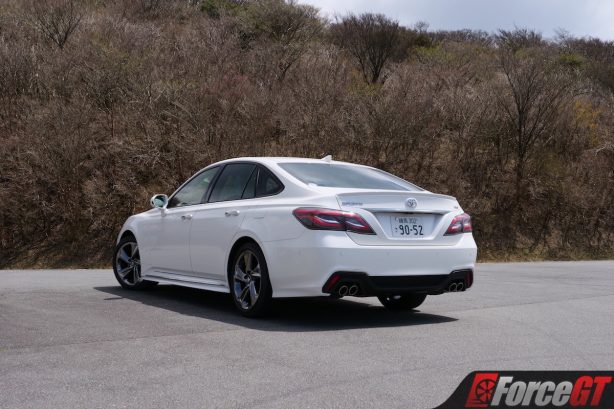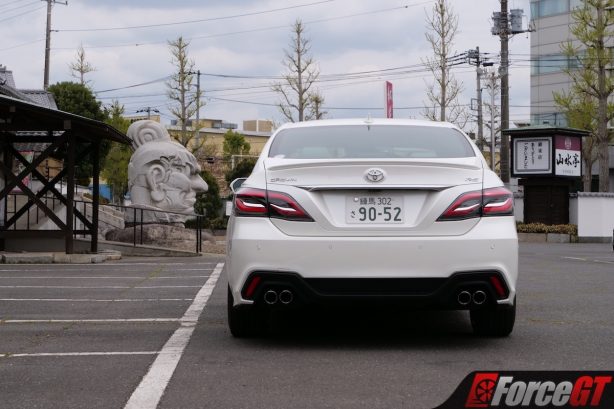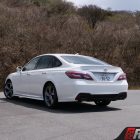When you’re a journalist, you’ll always be on the lookout for a story, just waiting to get that scoop that no one else has covered, and it was while planning a recent long-awaited holiday to Japan that I had one of those lightbulb moments and got an idea for something to write about.
Naturally, being a total car-nut, I wanted to get some seat time in something while I was over there to go and explore some of the country’s famous driving roads, and knowing that an all-new Toyota Crown had recently been launched over there, I knew I at least had to try and get my hands on one – not least to get something a little more entertaining than your average rental car.
So, a few months of back-and-forth phone calls and emails later, and I found myself in Tokyo holding the keys to the Crown you see here in RS Advance specification.
But before we get into this new model, it’s time for a bit of a history lesson. The Crown nameplate is actually the longest-running in the company’s history, with it first being applied to the back of one of many mid-size luxury sedans to end up wearing it all the way back in 1955. A little over a decade after its introduction, the Crown was not only introduced to the Australian market, but was actually assembled here in Port Melbourne until the late 1980s when it bowed out of our market.
Fast-forward to today and the Crown is still going strong in is home market of Japan, with the fifteenth-generation model you see here having been introduced in mid-2018.
The new Crown is an important car for Toyota not just because it has over 60 years of history behind it which it needs to live up to, and not just because it’s an incredibly popular model that can be seen everywhere in Japan, but because its the first car the company has produced that will be based on the TNGA-N platform, which will eventually replace the Toyota N platform that still underpins the Lexus IS, GS, and RC.
While I’d always thought the new Crown was a good-looker based on the pictures I’d seen on Toyota’s Japanese website, when I finally laid eyes on it in person, it looked even better in the flesh. The striking front end and its long side profile definitely helps it standout, as did the bright white pearlescent paintwork that really caught the light nicely.
But beyond that aggressive radiator grille – which is one that only a Toyota sold in Japan could get away with – it’s a fairly classy and conventional design otherwise. The only other oddity that stood out to me was the dark chrome alloy wheels, which I think actually suited it very well, although there are plenty of other finishes and designs if they aren’t your cup of tea.
Where the Crown really sets itself apart from your everyday Toyota models is on the inside, as it’s really in its own class there. The white leather interior of my tester may not be the most practical upholstery colour to opt for, but it certainly does look very classy, and the leather itself feels exactly like the high quality stuff usually reserved for Lexuses.
The next thing to stand out are the gauges, as the design of them is most unusual. The big crystal-clear screen sat between the speedo and tacho is nothing out of the ordinary, although it does look very slick, but the physical dials themselves are arranged with the illuminated numbers on a piece of perspex in front of the needles, with a coloured backlight behind them that changes depending on the driving mode selected. Never before have I been so taken by a gauge cluster, but the one in the Crown definitely caused me to pause and take it in for a second.
But the thing that tops the gauge cluster is the dual-screen infotainment system, which is where the Crown really sets itself apart. The interesting thing about it, unlike the two-screen system being employed in new Range Rovers, is that the top screen isn’t actually a touchscreen. Instead, it’s largely reserved for displaying the satellite navigation map, with the bottom screen being used for all interaction with the system.
And that bottom screen is one of the best I have ever used, I must say. It’s quick and incredibly responsive to the touch, and the little animations as you move between screens are slick and seamless. Kindly, the team at Toyota had configured it to all work in English prior to my arrival, and considering the system was operating in its second language, it did a pretty good job, although I did find one tiny glitch which was a resistance to the letter E on the keyboard when entering addresses. With no issues on that part of the screen while operating other features, I’ll give it the benefit of the doubt and assume it would run perfectly well in its home language.
To create a slick and largely button-free look to the interior, the vast majority of the car’s functions are hidden inside and controlled by this screen, from the climate controls – including the heated and cooled seats, heated steering wheel, and even the swing setting for the car’s air vents! – to its various drive modes to even the electric rear sunshade, the controls for all of them are tucked away in the infotainment systems many screens. I’ll admit to normally being a fan of having physical buttons to control everything, but when the screen is this responsive, I certainly can’t complain.
When I enquired about booking the Crown, Toyota actually asked me what specification I’d like it in, and there’s certainly a lot of choices to go for, and knowing I’d be pushing this thing around the twisting roads that surround Mount Fuji I wanted something a sporty as possible, and that meant opting for the RS Advance, although a standard RS model and a number of more basic and luxurious variants are also on offer.
Then, the question of drivetrain options came up, just to make my choice a bit harder. The big push with the Crown is for people to opt for the hybridised models, which come in two flavours – a 2.5-litre four-cylinder petrol paired to an electric motor and a CVT, which is available with either rear- or all-wheel drive, or a 3.5-litre V6 hybrid, which also has a CVT but is rear-wheel drive only.
Not being the biggest fan of CVTs, however, meant there was only one real option for me – the entry-level non-hybrid 2.0-litre turbocharged four-cylinder, which comes paired to an eight-speed torque converter automatic and rear-wheel drive, and that sounded like the perfect recipe for having some fun with.
That fun would have to wait, however, as my first day with the Crown saw me heading for Tsukuba to check out the Space Centre there and to hopefully snap some shots of the car along the way, but before all that could take place, I had to come to grips with the Japanese road network.
With Japan driving on the left just like we do in Australia, that’s one less thing to worry about, and the horizontally-mounted traffic lights actually make a lot of sense once you start to pay attention to how they work. The biggest change you’ll notice though is the attitude towards speed limits – in Japan, you can basically think of those signs as being minimums, not absolute maximums like they are here on our heavily-policed roads.
The most confusing thing I encountered, however, were tollgates. As I had to pay cash at each checkpoint – which the car certainly reminded me about by blurting out that an “ETC card is not inserted” constantly at the top of its voice – finding the right lane – that’d be the one with a green sign hanging above it – was always a challenge when busy, and I did manage to get it wrong one time and drove into one of the automated lanes. Thankfully, the system picked up on that quickly and I was given a ticket to pay at the next tollgate, but boy was it mighty stressful at the time.
Aside from the troublesome tollgates, the drive to Tsukuba and back was completely uneventful as the Crown makes for an utterly stellar highway cruiser. The eight-speed ‘box keeps the surprisingly small engine’s revs low, meaning it remains totally noiseless and relaxed. It also helped me match its 12.4km/L fuel economy claim when on the open road, although after a bit of thrashing, that figured ended up at the 12.0km/L mark when I handed back the keys – to translate those figures into Australian, they’re a very good 8.1 and 8.4L/100km respectively.
The other thing you notice is that the compliance of its ride is absolutely outstanding, as you never feel anything but the biggest of bumps. Combine the suspension tune with its cosseting seats, and it’ll come as no surprise that I drove an average of 220km each day that I had it without ever feeling worn out when I reached my destination.
But despite that suppleness of its ride, it never feels floaty or bouncy, instead remaining balanced and informative enough as to what’s going on with the road surface you’re driving on.
The spot-on suspension tune comes down to something I didn’t know about before I drove the Crown – and only found out while making my best attempt at reading the brochure included in the car’s press pack – which is that it was partially developed at the Nurburgring, and while its incredibly plush ride wouldn’t lead you to believe that, it truly becomes clear when you throw it into Sport+ and toss it into some corners.
Admittedly, it’s kind of hard to mess up the handling on a car like this – with a long wheelbase, rear-wheel drive, and near 50/50 weight distribution it has all the right ingredients – but the Crown manages to stand out with just how balanced it feels.
The legendary Hakone Skyline – and the many tight, twisting roads leading to it – were the perfect place for me to push the Crown a bit harder, and it handled everything I threw it at with aplomb.
It remains perfectly flat and feels properly stuck to the road through the gorgeous, perfectly-cambered twists and turns that lie in the shadow of the incredibly majestic Mount Fuji – and that’s despite it only sporting surprisingly skinny 225-section rubber all round.
That 2.0-litre turbo mill under the bonnet really starts to come alive up in the mountains, too. Where it had felt buttery smooth and effortless around town and on the highway, it felt lively and punchy when given some welly.
It’s a surprisingly responsive engine for one that’s turbocharged, with next-to-no lag to be detected, and it being a forced induction unit definitely helped with its performance at altitude.
The eight-speed transmission is stellar, too, with upshifts feeling particularly crisp and responsive when using the steering wheel-mounted paddles, while the cleverness of its shift programming when left to itself rivals that of BMW’s programming of its ZF-sourced transmissions. It always seems to be in the right gear at the right time, to the point at which you don’t notice what it’s doing at all – exactly what you want from an automatic.
So, there’s no doubt then that the Crown is a pretty stellar car, but there is one question that does beg answering – could it ever work here in Australia? – and that answer is more complicated than you might think.
In terms of the car itself, I’d say it would be a perfect fit for the incredibly poorly maintained roads we have here, given its plush but controlled ride. In that regard, it actually reminds me a lot of the Aussie-built Holden Commodores of old, given the mix of ride comfort, precise handling, and smooth power delivery.
It’d make a great competitor to the other mid-size luxury sedans we see here, too, such as the Jaguar XF and BMW 5 Series – both cars I love, but would happily pass up to have a Crown instead. Plus, given the fact it’s a Toyota, it’s a lot cheaper than its Euro-badged rivals, as at the current exchange rate at the time of publication, a 2.0-litre RS Advance like this starts from just over A$71,000, while one equipped like my tester will set you back A$82,727. I’d be happy to make the presumption that it would be more reliable, too.
But there are a few reasons I don’t foresee the Crown ever returning to Australia, at least officially, chief among which is that this thing would tread right on the toes of many Lexus offerings such as the IS and GS – especially given that there’s a good chance the next generation models of both could be based the Crown’s TNGA-N platform.
There’s also the fact that sedans simply aren’t what sells here anymore, and with Toyota offering a comprehensive range of SUVs locally, I’d say its fairly certain that they are aware of that fact.
But if you’re really itching to get one of these, there may be some hope. Older Crown models, along with the outgoing Mark X, have been seeing popularity as grey imports for a while now, and some new JDM Toyota models such as the Alphard have started to make their way Down Under as well, so while there’s little chance you’ll ever be able to walk into an Aussie dealership to put down your hard-earned on one of these beauties, you may be able to give your local import broker a call.
Verdict
Design & Comfort
Performance & Handling
Quality
Economy
Equipment & Features
OUR SCORE
4.3/5
+ Plus
- Incredibly plush ride
- High-quality cabin materials
- Smooth and refined drivetrain
- Perfectly-balanced handling
– Minus
- Not sold in Australia
- Minor infotainment glitches when running in English
Overall
There’s no doubt in my mind that the fifteenth-generation Toyota Crown is a real hidden gem, as it offers up the perfect mix of a luxurious ride and a plush interior, along with a punchy engine and incredibly balanced handling.
While it made a fine chariot for exploring the beauty of its home country, Japan, I don’t doubt it would feel to be in its element on Australian roads either.
However, there is of course that catch that the Crown is unlikely to ever be sold on our shores and will only ever find its way here as a grey import, so while you might be able to get your hands on one eventually, for now it will remain one of the best cars that we simply can’t have.
2019 Toyota Crown 2.0 RS Advance pricing and specifications
| Price (excluding on-road costs): | From: ¥5,594,400 (A$73,018) As tested: ¥6,339,060 (A$82,727) Tested options:
|
| Warranty: | 5 years/100,000km |
| Warranty Customer Assistance: | N/a |
| Service Intervals: | 12 months/15,000km |
| Country of Origin: | Japan |
| Engine: | 2.0-litre turbocharged direct injection four-cylinder petrol: 180kW @ 5,200-5,800rpm, 350Nm @ 1,650-4,400rpm |
| Transmission: | 8-speed automatic |
| Drivetrain: | Rear-wheel drive |
| Power-to-Weight Ratio (W/kg): | 104.1 |
| 0-100km/h (seconds): | N/a |
| Combined Fuel Consumption (L/100km): | Claimed: 8.1/Tested: 8.4 |
| RON Rating: | Petrol |
| Fuel Capacity (L): | 66 |
| Body: | 4-door sedan, 5 seats |
| Safety: | JNCAP not rated, 7 airbags, ABS, EBD, BA, VSC, Autonomous Emergency Braking, Lane Departure Warning, Lane Tracing Assist, Adaptive Cruise Control, Blind Spot Monitor, Rear Cross-Traffic Alert, Intelligent Clearance Sonar, Adaptive High Beam, Road Sign Assist, Preceding Vehicle Start Notification, 360-degree camera, ISOFIX |
| Dimensions (L/W/H/W-B): | 4,910/1,800/1,455/2,920 |
| Boot Space (L): | N/a |
| Turning Circle Between Kerbs: | 11.0 |
| Ground Clearance: | 135 |
| Kerb Weight (kg): | 1,730 |
| Towing Capacity (kg): | N/a |
| Entertainment: | 8.0-inch far-vision display, 7.0-inch colour touchscreen, AM/FM/DAB+, Bluetooth, Apple CarPlay/Android Auto, USB, AUX, iPod, 8-speaker stereo |
Competitors: Jaguar XF, BMW 5 Series, Mercedes-Benz E-Class, Audi A6
 ForceGT.com Car News, Car Reviews, Video Reviews, Tuning and much more.
ForceGT.com Car News, Car Reviews, Video Reviews, Tuning and much more. 













































